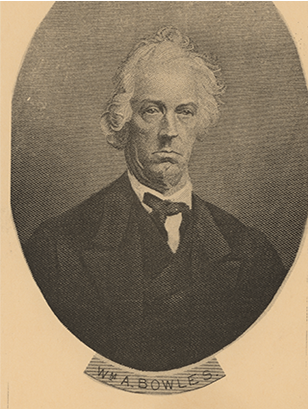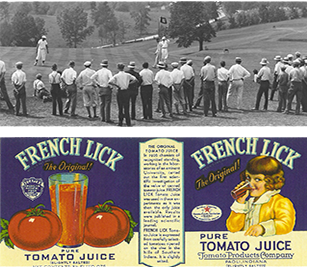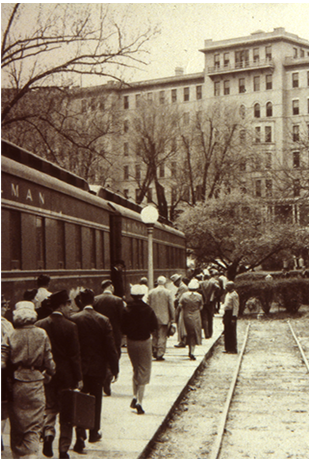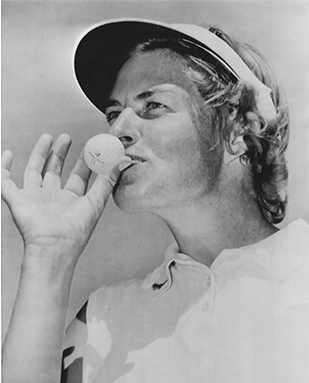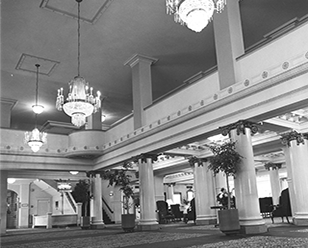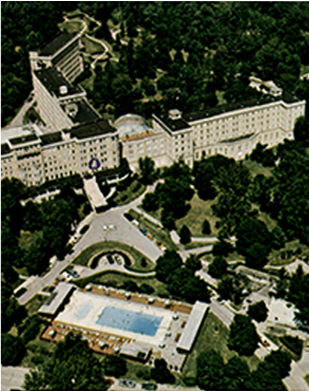PHONE: 888.936.9360
French Lick Springs and West Baden Springs Hotels were the iconic symbols of great economic achievement back in the early 1900s for rural southern Indiana. The region of Orange County, with its small towns of French Lick and West Baden, became a famed vacation and gathering place for wealthy and prominent society members.
In 1845, Dr. William Bowles built French Lick Springs Hotel, which drew guests from as far as 100 miles away to partake of the “miracle waters” from the sulfur springs that naturally surfaced in the area. Five years later, another doctor by the name of John Lane saw the success of French Lick Springs Hotel and decided to build his own health resort just one mile up the road and named it Mile Lick Inn. He later changed the name of the hotel, and the town, to West Baden Springs after the famous mineral springs in Wiesbaden, Germany.
Lee W. Sinclair transformed West Baden Springs Hotel into a sophisticated resort when he assumed ownership in 1888. He added an opera house, golf courses, church, ball field and double-decker pony and bicycle track. A fire ravaged the hotel in 1901 but Sinclair used the opportunity to further transform West Baden Springs Hotel into a world-class facility. With a $414,000 budget and a one-year timeline, Sinclair erected a hotel modeled after the grandest spas of Europe, complete with the world’s largest free-span dome which stretched 200 feet.
That same year, French Lick Springs Hotel also rose to international prominence after Indianapolis Mayor Tom Taggart purchased the property. He expanded the hotel and added luxurious furnishings and marble floors, designed two championship golf courses and started bottling Pluto Water for national sale. During this time, Mr. Taggart became the Democratic National Chairman and French Lick Springs Hotel became the unofficial headquarters for the Democratic National Party. During the National Governor’s Conference at French Lick in 1931, Franklin Delano Roosevelt rounded up support for the party’s presidential nomination; a year later he became the official Democratic candidate and won the presidency in 1932.
While French Lick Springs Hotel remained a functioning resort over the next 100 years, the same could not be said for West Baden Springs Hotel. After the stock market crash of 1929, the hotel was sold to the Society of Jesus for one dollar in 1934. The Jesuits removed many of the building’s elegant appointments and operated it as a seminary for 30 years. Northwood College was the next tenant, from 1967 to 1983, and then the magnificent building sat unoccupied for 13 years.
When a 180-foot, six-story section of West Baden Springs Hotel collapsed in 1991, it crumbled further from its glory days. The once-lavish hotel — dubbed the “Eighth Wonder of the World” by journalists when it opened — was reduced to a pile of rubble. It now had a not-so-prestigious place on the National Trust’s list of 11 Most Endangered Historic Properties in the United States.
Luckily for the withering structure, help was nearby. Indiana Landmarks, the largest nonprofit preservation group in the nation, partnered with philanthropists Bill and Gayle Cook to make a permanent, positive impact on both the hotel and the depressed region around it. In addition to pioneering medical advances, Bill and Gayle, along with son Carl, had become revered leaders of the American historical restoration movement by acquiring and rehabbing dozens of buildings throughout the state. They wanted their work to result in living, breathing historic places that would be around for centuries to come.
French Lick Resort was the ideal target. Mr. Cook’s initial handshake on a multi-million dollar pledge for the stabilization and partial renovation of West Baden Springs Hotel got the ball rolling on a much more ambitious plan than anyone could have imagined. Their investment not only saved West Baden Springs Hotel, but also restored French Lick Springs Hotel to its former glory.
The refurbished French Lick Springs Hotel and its new casino officially opened in November 2006, and the large part of the restoration of West Baden Springs Hotel started the next day. When it was all said and done, it required about $600 million in renovations to create the resort you see today. More than a decade after “The Save of the Century,” tourism is once again thriving in the area.
For more than 175 years, a lodging establishment has operated at the current site of French Lick Springs Hotel. It all began with Dr. William Bowles and continued to thrive under various owners. It was under Tom Taggart's innovative direction that French Lick Springs Hotel made great strides in décor, development and transportation. He also built pavilions for the springs and added a new bath building on the current site of the Spa at French Lick Springs Hotel. After Taggart’s son eventually sold the hotel, it was owned by five companies over a span of 60 years, operating out of five different states. In 2005, French Lick Springs Hotel was purchased by Indiana-based Cook Group, Inc. and after a complete restoration, it returned the hotel back to its historic splendor.
In 1845, Dr. William Bowles, a physician from nearby Paoli, Indiana, built a three-story wooden framed hotel he named French Lick Springs Hotel. Bowles used his knowledge as a physician to explore the healing properties of the abundant mineral springs in this area.
Outgoing mayor of Indianapolis, Thomas Taggart, along with a small group of investors, formed the French Lick Hotel Company and bought the property in 1901. Taggart’s improvements included enlarging the east wing (now known as the Spa Wing), encouraging the Monon Railroad to lay a special spur and run daily trains between Chicago and the front entrance of the hotel, and modernizing and expanding the mineral springs for which the hotel was becoming famous. He used the yellow "French Lick Brick," scagliola (faux marble) and Italian mosaic floors. He also built a new bottling house for water from his Pluto Spring for national distribution and brought electricity, a freshwater system and a trolley line to the town.
While French Lick Springs Hotel was expanding, the game of golf was gaining popularity worldwide. In 1907, Taggart hired Tom Bendelow to design the resort’s first championship golf course, known at the time as the Springs Valley Golf Links Course. Bendelow’s design was completed by 1910.
In 1917, Donald Ross — a well-known golf architect — was hired to design and build the French Lick Springs Golf Course two miles southwest of French Lick Springs Hotel. The locals referred to it as “The Hill Course.” Completed in three years, Ross’s course consisted of unconventional bunkers and steep curves. Also in 1917 while the Ross Course was under construction, world-famous chef Louis Perrin created the first tomato juice as a drink after he ran out of oranges one morning at the resort and could not serve the traditional orange juice.
The PGA Championship was held on the Donald Ross Course in September of 1924. Walter Hagen defeated former champion Jim Barnes in the final round. The victory was the beginning of a four-year PGA winning streak for Hagen.
While Taggart served as the chairman of the Democratic National Committee prior to his death, French Lick Springs Hotel developed a reputation as the unofficial headquarters of the national Democratic Party. At the 1931 National Governors’ Conference held at French Lick Springs Hotel, Franklin D. Roosevelt rounded up support for his party’s presidential nomination. Roosevelt received his official nomination one year later in Chicago.
Thomas D. Taggart took over ownership of the hotel upon his father’s death in 1929. Under his ownership, French Lick Springs Hotel survived the dark days of the Great Depression and saw a growth in convention business. On Nov. 29, 1946, Thomas sold his prized hotel to a syndicate out of New York City. For the first time in more than 45 years, the French Lick Springs Hotel belonged to someone other than a Taggart.
A few months after Thomas D. Taggart's death in January 1949, the infamous Derby Weekend Raid on illegal gambling was conducted in French Lick by Indiana State Police. Hotel guests returning by train from the Kentucky Derby were shocked to find chains on the doors of the gambling establishments throughout town. The new governor had pledged to end gambling in French Lick and he did so on one of the busiest hotel weekends of the year.
In 1955, the French Lick Springs Hotel was bought by the Sheraton Corporation, which began a grand remodel of the hotel in an effort to modernize it. Visible changes included lowering a number of ceilings covering the ornate plaster cornices and covering numerous wooden and marble floors as well as the mosaic tiles in the lobby with black and white linoleum square tiles and carpet.
Competitive women’s golf got its start in French Lick in 1958, when the Donald Ross-designed Hill Course hosted the inaugural French Lick Women’s Open with Hall of Famer Louise Suggs winning that tournament. This event was such a surprise success that, for the next two years, the Ladies Professional Golf Association brought its coveted LPGA Championship to French Lick. In 1959 Betsy Rawls won the major title, the first of her two LPGA Championships titles, and the legendary Mickey Wright took home the title in 1960. That was the fourth of Wright’s 13 major titles.
Sheraton sold the hotel to the Cox Hotel Corporation of New York in 1979. Other than the hotel being renamed as French Lick Springs Golf and Tennis Resort, little changed around the property under this new ownership. Many of the employees remained at the hotel, and convention business remained steady. French Lick Springs Hotel continued to change ownership for the next few decades.
In the 1980’s, the land behind the French Lick Springs Hotel was purchased by Maryland businessman Norman R. Rales’ company with the intent to build villas on the land. Eventually becoming timeshare packages, the French Lick Springs Villas grew to over 50 in number by the time Rales’ company purchased the hotel and its grounds in the mid-80s. Vacationers purchasing time at the villas were also able to use the hotel’s amenities.
Five years after purchasing the resort, Norman R. Rales decided to retire from the business and put the resort up for auction in 1991. Nearly five minutes after bidding began on auction day, the resort had a new owner. Luther James of Louisville, Kentucky, bought the hotel for $2.6 million and immediately began work on restoring the hotel to its previous state of grandeur. He began by undoing many of the renovations conducted by the Sheraton, including restoring the lobby’s mosaic floor tiles. James also gave the guests rooms a much-needed upgrade with new wallpaper, carpeting, paint, furniture and up-to-date heating and air-conditioning units. He paid significant attention to the lobby by bringing in antique pieces of decoration, adding curtains and completely repainting the area. The exterior of the hotel also received a fresh coat of paint and hundreds of flowers were planted.
After six years of ownership, James decided to sell the resort in 1997 and move on to his next big project. Boykin Lodging Group, based in Cleveland, Ohio, bought the hotel for approximately $20 million. Boykin operated hotels from the Midwest to Florida, and the purchase of the French Lick Springs Hotel was the largest resort hotel in their portfolio at the time. Boykin continued with the restoration upgrades that had been started by James.
In the spring of 2005, a partnership led by Cook Group, Inc., a global medical device manufacturing company headquartered in Bloomington, Indiana, purchased French Lick Springs Hotel and West Baden Springs Hotel. Under the direction of Bill and Gayle Cook and their son Carl, both hotels and their grounds received a multi-million dollar renovation, returning them to the grandeur of the days of Taggart and uniting them as one resort. That summer, with renovation work underway, Blue Sky, LLC officially acquired the 11th and last available casino license from the Indiana Gaming Commission. French Lick Springs Hotel remained open during the beginning of construction, but as concerns arose, the hotel was forced to close in November.
The Donald Ross Course at French Lick (formerly the Hill Course) reopened in September 2006 after a $4.6 million restoration. This rehaul returned the course to Donald Ross’ early vision. One year after closing, French Lick Springs Hotel reopened after an extensive renovation. On the same day, the French Lick Casino held its grand opening, becoming the first land-based casino in Indiana. With the completion of the West Baden Springs Hotel restoration in 2007, French Lick Resort was born.
French Lick Casino underwent an extensive renovation in 2009. The exterior of the casino was transformed from resembling a steamboat on water to the appearance seen today. Additions on the interior included an increased number of slots, a bar, table games, VIP lounge and a new high-limits section.
In 2013, women’s professional golf returned to the area for the first time in 50 years when French Lick Resort hosted The Legends Championship featuring 70 of the top players in LPGA history at The Pete Dye Course. Past champions of the tournament include Lorie Kane, Laurie Rinker and Juli Inkster. The Dye Course has continued hosting the Senior LPGA event every year since.
French Lick Resort brought trolley service back to French Lick and West Baden at the end of 2014. The trolley’s history spans many decades, starting in 1903, when it ran from the steps of West Baden Springs Hotel into downtown French Lick. The advent of the automobile put the brakes on the trolley service in 1919. After years of hard work, our newly restored trolley is again running between the two hotels.
A $20 million expansion of the Event Center was completed in January 2015, increasing the capacity to more than 105,000 square feet of meeting space. The overall expansion of 58,000 square feet, including a 22,000-square-foot adjustable ballroom, allows the resort to accommodate national conventions and large corporations that require larger space. On May 21-24 of 2015, the 76th Senior PGA Championship presented by KitchenAid was held at The Pete Dye Course. Defending champion Colin Montgomerie of Scotland successfully defended his title with an 8-under-par, beating former boxer Esteban Toledo of Mexico.
 In 1855, the Mile Lick Inn was built to capitalize on the abundance of mineral springs in the area. The name was later changed to West Baden Springs Hotel as it was fashioned after Baden-Baden, the great mineral spa of Europe. Lee W. Sinclair transformed West Baden into a sophisticated resort, adding an opera house, a casino, a two-deck pony and bicycle track and a full-size baseball field. Sadly, in June of 1901 a fire destroyed the entire lodging structure in less than two hours. Thankfully, all of the guests escaped harm.
In 1855, the Mile Lick Inn was built to capitalize on the abundance of mineral springs in the area. The name was later changed to West Baden Springs Hotel as it was fashioned after Baden-Baden, the great mineral spa of Europe. Lee W. Sinclair transformed West Baden into a sophisticated resort, adding an opera house, a casino, a two-deck pony and bicycle track and a full-size baseball field. Sadly, in June of 1901 a fire destroyed the entire lodging structure in less than two hours. Thankfully, all of the guests escaped harm.
Sinclair used this tragedy as his opportunity to build the hotel of his dreams. He envisioned a circular building topped with the world's largest dome, decorated like the grandest spas of Europe. Architect Harrison Albright of West Virginia accepted Sinclair’s commission and agreed to complete the project within a year. The new hotel, complete with a 200-foot diameter atrium and fireplace that burned 14-foot logs, opened for business in June of 1902.
After Sinclair passed away in 1916, Lillian began a grand renovation that continued until 1923. She left her mark in the atrium with a floor-to-ceiling transformation while also redoing the lobby and eventually the gardens. Before the outside renovations began, Lillian leased the hotel to the government and closed it to guests in the fall of 1918 while it served United States Army Hospital #35 for WWI soldiers returning from overseas. After the war ended and the hotel was returned to the Sinclair family, Lillian’s grand renovations resumed. However, because of those extensive renovation plans, she soon found herself indebted to local businessman Ed Ballard to the tune of $500,000. In September of 1923 Lillian made the decision to sell the West Baden Springs Hotel to Ballard for $1 million – half in cash and half in debt cancelation.
When the stock market crashed in 1929, the hotel emptied of guests almost overnight. Ballard eventually closed the hotel in June 1932, and in 1934 he sold it to the Jesuits for one dollar. The Jesuits removed many of the property’s elegant appointments and eventually dismantled the building's four Moorish towers. The seminary, known as West Baden College, operated until 1964 when declining enrollment led the Jesuits to close the facility. A Michigan couple purchased the property in 1966 and donated it to Northwood Institute, a private college that operated in the building until 1983.
While the colleges did not maintain the West Baden property in the same lavish style of the hotel in its prime, it was relatively well cared for until 1985 when Northwood sold it to a real estate development firm. That firm soon declared bankruptcy and the property was tangled in years of litigation.
In 1974, West Baden was listed as a National Historic Landmark but the elements took their toll on the neglected hotel and it was closed to the public in 1989 for safety reasons. In January 1991, a buildup of ice and water on the roof and in drainpipes caused the collapse of a portion of the exterior wall. Indiana Landmarks, the country’s largest statewide historic preservation organization, led the charge to stabilize the hotel to preserve redevelopment potential, and attract a new owner capable of restoring the property for a new use. In 1992, Indiana Landmarks spent $140,000 to stabilize the hotel, matching a $70,000 contribution from an anonymous donor.
In May 1994 the hotel was sold to Minnesota Investment Partners (MIP) for $500,000. Grand Casinos Inc., an investor in the purchase, optioned the hotel from MIP. The Cook Group Inc., a global medical device manufacturing company headquartered nearby in Bloomington, stepped in to preserve both the French Lick and West Baden Springs Hotels. Under the direction of Bill and Gayle Cook and their son Carl, both hotels and their grounds received a multi-million-dollar renovation, returning them to the grandeur of the days of Sinclair and uniting them as one resort. In 2006, French Lick Springs Hotel reopened after an extensive renovation and a new addition, French Lick Casino. The original 1917 “Hill Course” was reopened and restored as The Donald Ross Course. With the completion of the West Baden Springs Hotel restoration in 2007, French Lick Resort was born.
From the first hotel built at French Lick in 1845 to the newest one finished in 2019, French Lick Resort is rich with history. From guided tours to our new museum space there are various ways to learn about our famous mineral water, history of gambling and grand restorations. Or, maybe you just prefer to experience it at your own pace. No matter your preference, there is history around every corner here and we want you to experience it.
11am • West Baden Springs Hotel
$18 Adults • $8 Children 12 and younger
Reservations recommended: (812) 936-5579
Join our French Lick Resort Historian and step back in time to discover the captivating history of West Baden Springs Hotel in this 75-minute walking tour. From the majestic dome down to the intricate tile floor, this majestic hotel has decades of stories to tell. Tickets can be purchased from the West Baden Mercantile. Tour begins at the concierge desk.
No Tour on February 9
Management reserves the right to cancel or modify all promotions and events without notice
April 6 & 20
May 4, 11, 18
June 8 & 22
11am
West Baden Springs Hotel • Concierge Desk
$25 adults • $15 children 12 and younger
Reservations required: (812) 936-5579
Take a ride on our trolley and join our resort historian for an hour to learn about the historic towns of French Lick and West Baden. Tickets can be purchased at the West Baden Mercantile.
2pm & 4pm
West Baden Springs Hotel • Landmarks Emporium
$18 for adults • $8 for children (ages 6-15) • Free for children 5 and younger
Step back in time and discover the captivating history of West Baden Springs Hotel. Find out how the hotel's dome was constructed and discover how this colossal hotel was built in less than a year. Learn more about the mysterious Angel Room high above the atrium. And find out who those movers and shakers were that came here to make deals, gamble and "take the waters" in the early 20th century.
Noon
French Lick Springs Hotel • Landmarks Emporium
$18 for adults • $8 for children (ages 6-15) • Free for children 5 and younger
Learn about French Lick Springs Hotel's amazing history, from the creation of tomato juice in 1917 to the infamous Derby Weekend Raid of 1949 when gambling became suddenly taboo — even in French Lick. Discover why Pluto Water was world-famous, and which revered U.S. president started his first run for office right here. Hundreds of celebrities have stayed at the resort, from actors to athletes to musicians. This is definitely a place known for its successes and secrets.
Opened in 1902, West Baden Springs Hotel enjoyed national prominence as an architectural marvel, with its 200-foot dome. On this tour, you'll learn about the past and present buildings, the four springhouses, a bicycle track and ball park where Major League Baseball teams trained.
Continue your tour at French Lick Springs Hotel and you'll learn more about the first visitors to the hotel in 1845, the world-famous Pluto Water and the people who put French Lick on the map. You'll also learn how the site went from a fort to the grand hotel you see now.
Open daily
Complimentary admission
Located near the Mineral Springs exit in the atrium, our museum displays artifacts and it highlights some of the remarkable feats of this hotel's storied history. Read about its past owners. Find out how long it took to build the dome in 1902. See how it rose from the ashes in the 1990s.
Management reserves the right to cancel or modify all promotions and events without notice.
Tuesdays • 2pm - 3pm
Thursdays • 11am - Noon
West Baden Springs Hotel Museum
Have questions or want to learn more about our hotels? Our Resort Historian is your answer man. Stop by the West Baden Springs Hotel Museum for a Q&A session and talk some history.
Follow the clues and learn about the rich tradition of our two historic hotels. These self-guided hunts will open your eyes to the unique details and colorful history of these properties that trace their roots to the 1800s.
Access your clue sheets here, or pick up a hard copy at the Activities Center (in front of French Lick Springs Hotel) or the West Baden Springs Hotel Museum.
Management reserves the right to cancel or modify all promotions and events without notice.
